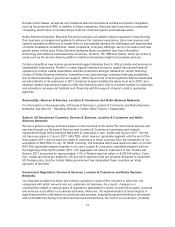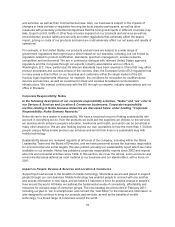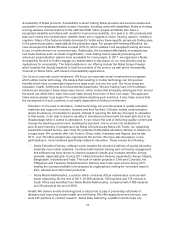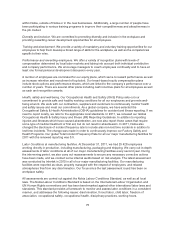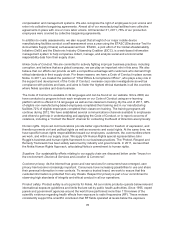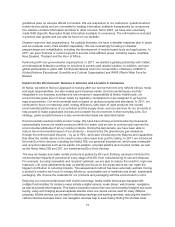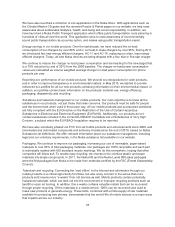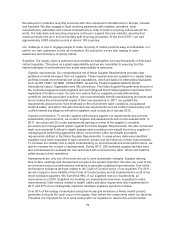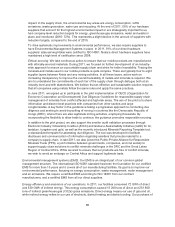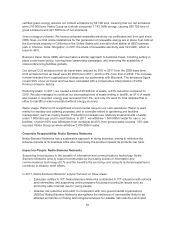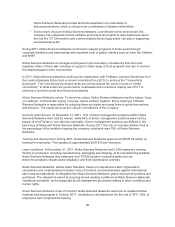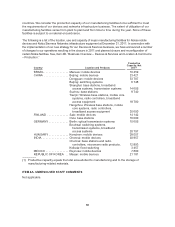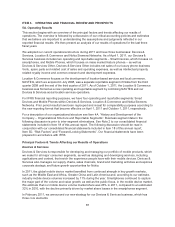Nokia 2011 Annual Report Download - page 80
Download and view the complete annual report
Please find page 80 of the 2011 Nokia annual report below. You can navigate through the pages in the report by either clicking on the pages listed below, or by using the keyword search tool below to find specific information within the annual report.We have also launched a collection of eco applications in the Nokia Store. With applications such as
the Climate Mission 3D game and the renewed People & Planet pages on our website, we help raise
awareness about sustainable lifestyles, health, well-being and social responsibility. In addition, we
have launched a Nokia Public Transport application which offers public transportation route planning in
hundreds of cities all over the world. This application aims to raise awareness of environmentally
sound public transportation as a journey option, and makes using public transportation easier.
Energy-savings in our mobile products. Over the last decade, we have reduced the no-load
consumption of our chargers by over 80% and in our best-in-class chargers by over 95%. During 2011,
we introduced two new energy efficient chargers, AC-11 and AC-16, replacing our older, less energy
efficient chargers. Today, all new Nokia devices are being shipped with a four star or five-star charger.
We continue to reduce the charger no-load power consumption and are heading for the new target that
is a 75% reduction by end of 2012 from the 2006 baseline. The charger no-load power consumption
values are calculated as volume weighted average charger no-load power consumption for phone
products per year.
Reporting eco performance of our mobile products. We provide eco declarations for older products,
and in order to improve transparency in environmental matters, in May 2010, we started to provide
enhanced eco profiles for all our new products containing information on their environmental impact. In
addition, eco profiles contain basic information on the products’ material use, energy efficiency,
packaging, disassembly and recycling.
Substance and materials management in our mobile products. Our main objective is to know all the
substances in our products, not just those that raise concerns. Our products must be safe for people
and the environment when used in the proper way. All our mobile products and accessories worldwide
are fully compliant with the EU Directive on the Restriction of the Use of Certain Hazardous
Substances in Electrical and Electronic Equipment (EU RoHS). Additionally, our products do not
contain substances included in the current EU REACH Candidate List of Substances of Very High
Concern, a subject which the EU REACH regulation requires to be reported.
We have also voluntarily phased out PVC from all mobile products and enhancements since 2006, and
brominated and chlorinated compounds and antimony trioxide since the end of 2010, based on Nokia
Substance List definitions. We offer relevant information about our substance management, including
legal and our voluntary requirements, in the Nokia substance list available on our website.
Packaging. We continue to improve our packaging, increasing our use of renewable, paper-based
materials to over 95% of total packaging materials. Our packages are 100% recyclable and each part
is individually marked with ISO standard recycle markings. We do this everywhere, hoping that other
companies will follow suit. To enable easy recycling, we choose not to combine plastic and paper
materials into single components. In 2011, the Nokia N9 and the Nokia Lumia 800 sales packages
were the first packages from Nokia to be made from materials certified by the FSC (Forest Stewardship
Council).
Take-back and recycling. Connecting the “next billion” to the Internet and information through our
mobile products is a critical opportunity for Nokia, but also a key concern in the sense that more
products sold means more “e-waste” from old devices as well. Mobile products contain potentially
hazardous materials, which can leak out into the environment in improper recycling practices such as
landfill or open air burning. In addition, this e-waste contains valuable metals that can be recovered
through proper recycling. Of the materials in a mobile device, 100% can be recovered and used to
make new products or generate energy. These facts, combined with a finite supply of raw materials
available for producing new phones, demonstrate that the end-of-life of mobile devices is a major issue
that impacts across our industry.
78





